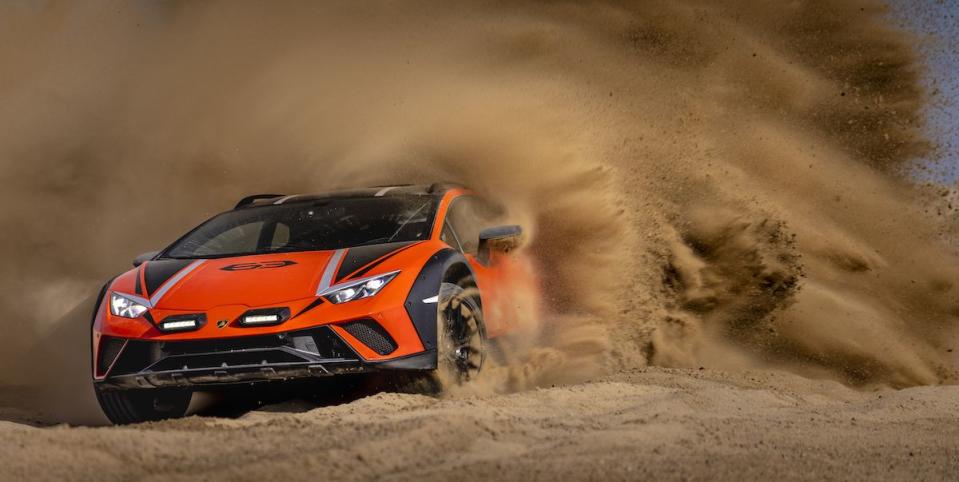Lamborghini Huracan Sterrato Offers a Remarkable Balance of Dirt and Asphalt

Lamborghini Huracan Sterrato takes the supercar where it has never been.
602 hp to all four wheels makes this a dirt-flingin' funster.
Only 500 are slated for the US, at $273,177, with most already spoken for.
Heading straight off the pavement and into the desert dirt, your brain’s first inclination is to scream “NOOOO!” Somewhere in your noggin is a primitive instinct that says Lamborghini supercars are not supposed to go there. If they do, you have made a terrible mistake, and you are going to be digging pebbles out of your tire beads for days, or worse.
But no, this Lamborghini Huracan is actually supposed to go off track, into the dirt, and keep going, often sideways.
The Lamborghini Huracan Sterrato was officially created by a few guys on the Urus engineering team. They had just finished the Urus and were driving it around off-road on some of the few off-road-capable areas in Italy where you can drive and won’t get arrested, and they thought, “Why not do this same thing with something like—hey, how about that Huracan over there?”

Indeed, they took a Huracan Performante development car that was just lying around and transformed it into roughly what you see here: the fully off-road-capable Lamborghini Huracan Sterrato.
It had been done before, by Lamborghini and by others. Lamborghini’s own legendary engineer and test driver Bob Wallace created rally-style versions of the Urraco and Jarama in the 1970s. Lancia built the Stratos HF from 1973-1978, the greatest rally car ever made, bar none. Porsche made the 1984 911 Carrera 3.2 4x4 Dakar 953 that won the 5000-mile race that year and inspired the current Porsche Dakar. And Giugiaro created coupe and cabriolet versions of its magnificent, Lamborghini-V10-powered Parcour concepts at Geneva in 2013 (as well as the all-electric Kangaroo concept in 2019).
But none of that comes up in the official reading of the roots of the Sterrato. Officially, the engineers came up with the idea, and when the dashing Stephan Winkelmann made his triumphant return to Lamborghini in 2020, he immediately gave it the green light. We like Winkelmann.
The basis of the Sterrato is mostly Huracan Tecnica and/or STO, a great place to start. The Sterrato gets a 602-hp 413-lb-ft version of the Huracan’s V10 mounted longitudinally behind the seats and powering all four wheels. Now, maybe you think you’d have more fun with rear-wheel-drive only. Maybe you would, maybe you wouldn’t. In a minute I’ll tell you it was a ton of fun with AWD pushing and pulling the car around in the dirt.
That V10 is mated to a 7-speed dual-clutch transmission and electronically controlled all-wheel drive with rear mechanical self-locking differential “designed to offer optimum performance on loose surfaces.” On firm surfaces it’ll hit 62 mph in 3.4 seconds and will top out at a tire-limited 160 mph (some references say 162). Bridgestone made a bespoke tire for the Sterrato that would perform on both dirt and pavement at speeds at which most pure off-road tires would come flying apart.
Since there’s nowhere to stow a spare, the tires are run-flats. That adds some unsprung weight but not as much overall weight as it would if you had to carry around a spare tire on top of the deck lid. And the extra toughness of a run-flat in the dirt is appreciated. The Dueler All-Terrain AT002 combines tread big blocks with a firm tread surface on top of the blocks to perform well in both environments. And don’t stop driving it in winter, either. Bridgestone makes a Sterrato-specific winter tire, too.
Another concession to off-road use is the big snorkel on the roof, slurping in air that has a much lower dirt content than it would if Lambo stuck with the side air intakes (which are blocked off on the Sterrato). Only problem is the snorkel blocks all vision out the back window. Why not install a rear-view camera, projected in the rear-view mirror? They had no good answer.

 Yahoo Autos
Yahoo Autos 